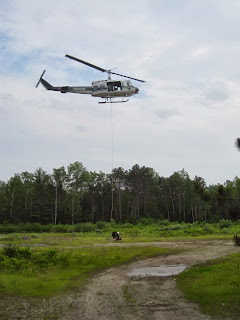On Monday, July 1, 2013, we issued the following press
release:
PRESS RELEASE
July 1, 2013
FOR IMMEDIATE RELEASE
Contact Person: Park Director Jensen Bissell
(207) 723-9500
(207) 356-2318
Injured Hiker Evacuated from the Hunt
Trail in Baxter State Park
A 62 year old hiker from
Texas was air lifted from a mountain peak in Baxter State Park on Monday
afternoon after suffering an upper and lower body injuries from a large rock
falling on him.
After an assessment by a Park
Ranger on the scene, Ned Hamara was transported by a Maine Forest Service helicopter
to Caribou Pit in Baxter State Park. The
Forest Service utilized a short-haul system to extract the injured hiker from
the approximately 3,900’ elevation and transport him to the open area of
Caribou Pit where he was transferred to a waiting ambulance for transport to Millinocket
Regional Hospital for treatment shortly after 4:00 pm.
End Release
This press release was by design a very compressed version
of what had been a complex and effective evacuation of an injured hiker from
steep, rocky and timbered terrain. It
was also the first “short-haul” rescue ever implemented in Baxter State
Park. It will almost certainly not be
the last.
Short-haul rescue refers to the technique of using a fixed
length of line attached to a helicopter to land a crew member with medical
training to perform an assessment on an injured or ill hiker and prepare the
patient for evacuation and then to evacuate the patient and crew member and fly
both to the nearest access point for advanced life support (ALS).
Photos courtesy Maine Forest Service
Short-haul rescue provides the opportunity for the
relatively rapid access of medical support to a patient or patients located in
very steep, rocky or forested terrain where the landing of a helicopter is not
an option. Unless the helicopter is
equipped with a winch capable of raising and lowering a crew member and patient
from an access door, rescuers only option in this terrain is to secure the
patient in a litter and carry them either down and out, or up to an area where
a helicopter can land.
The Maine Forest Service has worked very effectively and
professionally to add the short-haul technique to the skill sets of MFS
helicopter crews and pilots. Thanks to
the commitment of this agency, the Park now can include an important and
life-saving option to rescue and evacuation considerations in the Park.
While the photos above depict the flight segments of the
short haul system, in real life – in the trees, steep terrain and available
weather and beneath a powerful rotor driven aircraft– a short haul evacuation
is a noisy and raucous event requiring cool heads, steady hands and good
communication. The short haul evacuation
in July was filmed by a Park hiker and is a testament to the careful training
and professional approach of everyone involved.
The video can be viewed here:
Any evacuation from backcountry areas, particularly the
steep, rocky and remote areas common to the wilderness zone of Baxter State
Park includes some elements of risk.
Litter-carry evacuation efforts in high elevation areas of the Park
often involve more than 40 people. In these evacuation operations, it is common
for people to focus on the risks to the patient, but risk elements extend to
all participants and injuries to rescuers working on an evacuation or a search
can and do occur. Evacuation team
leaders work hard to maintain a safe workplace and a culture of safety on the
rescue site during evacuation operations.
Helicopter evacuations also involve risk. Helicopters are complex machines and mountain
rescue operations require pilots to maneuver helicopters near or over rough and
variable terrain in often strong and changeable winds.
The specific variables in each rescue, including patient
condition and trending, current and forecasted weather, available ground
personnel and the relative risks of existing evacuation options are carefully
weighed by the incident commander before committing to an evacuation plan.
Of course the safest evacuation is the one that doesn’t
happen. That’s why our efforts to
encourage hikers to hike safely, be prepared for the conditions, make good
decisions on the trail, and set a turn-around time and stick to it. We will always hope for the best, but when things go badly wrong on Katahdin, short-haul evacuation is a great tool to have!
.JPG)

